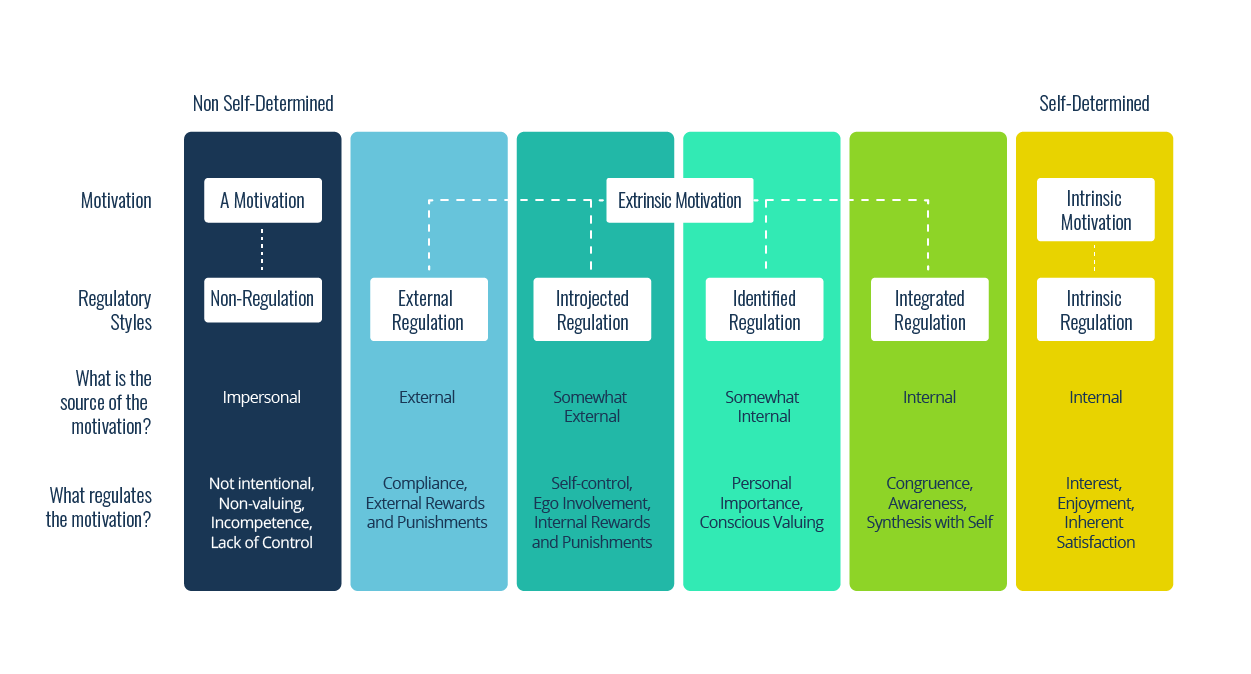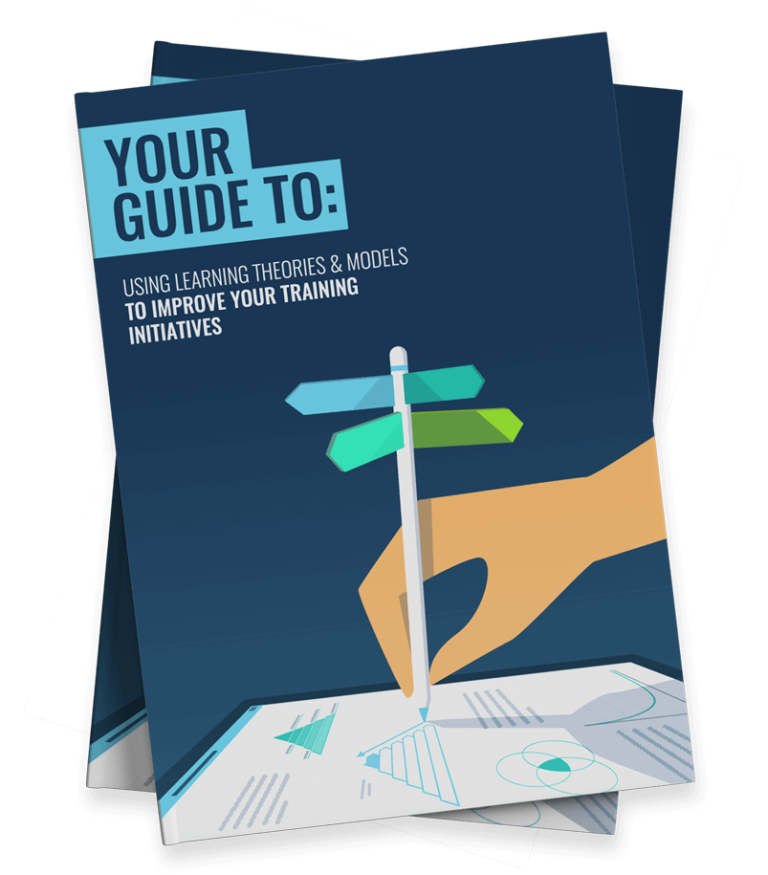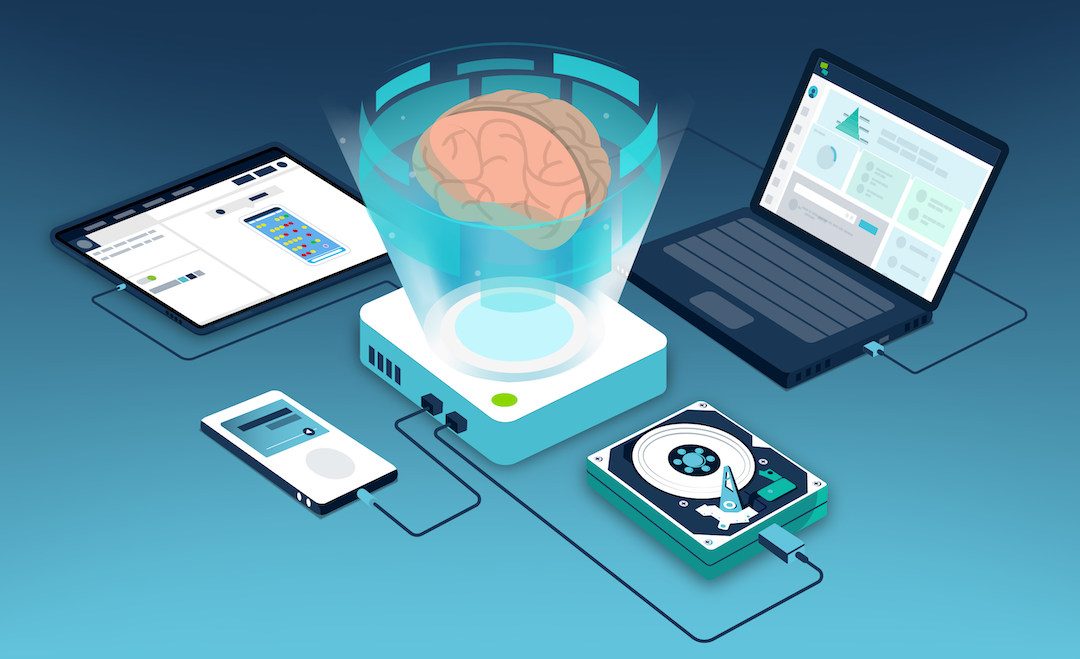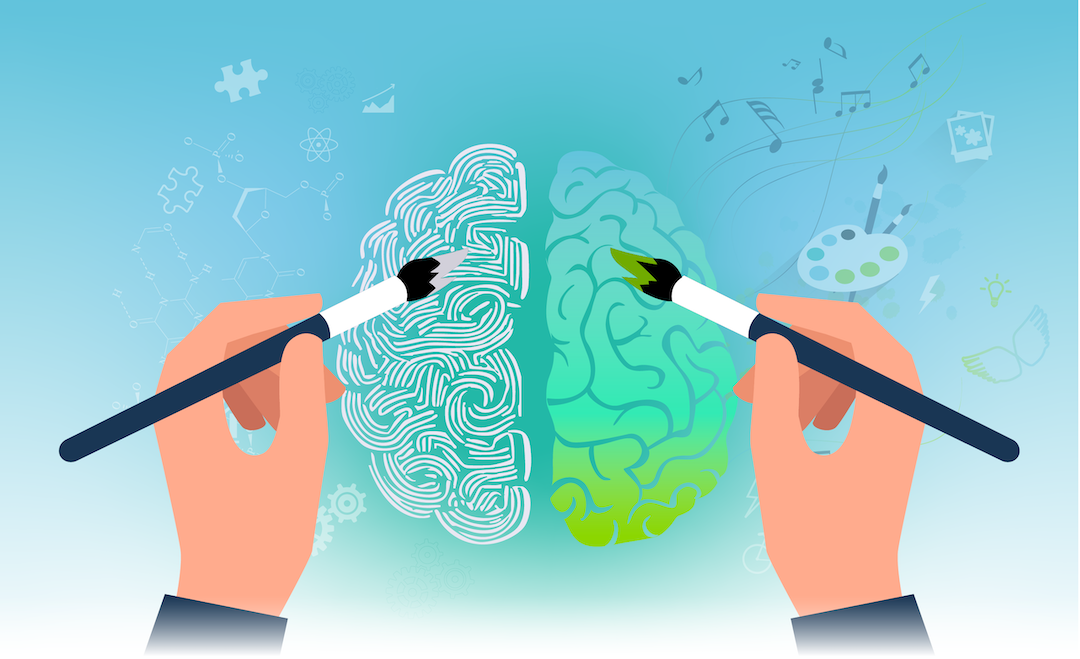Dwight D. Eisenhower once said: “Motivation is the art of getting people to do what you want them to do because they want to do it.” But motivation rarely comes easy. Thankfully, Self-Determination Theory can help.
Indeed, parents, teachers, managers and L&D professionals around the world often struggle to motivate their kids, students or employees.
And it’s little wonder why. There are various different external and internal factors that have a great impact on our motivation. While one may be motivated by grades, employer feedback or bonuses, other individuals may be motivated by their interests, curiosity and hunger to learn.
This interplay between extrinsic factors and intrinsic motives and needs is the core of Self-Determination Theory.
In the context of L&D and online learning, this theory can help you understand learner motivation and create engaging and emotionally-centred learning experiences.
Self-Determination Theory
Self-Determination Theory (SDT) is the brainchild of two psychologists, Richard Ryan and Edward Deci.
They identified the key ingredients needed for intrinsic human motivation and introduced their ideas in their 1985 book, ‘Intrinsic Motivation and Self-Determination in Human Behavior’.
Ryan and Deci developed SDT, a theory of human personality, motivation and self-determination. Self-determination means our ability or power to make decisions for ourselves. Based on this, the theory suggests that people tend to be driven by a need to grow and gain fulfilment.
They have since refined their theory multiple times, and it’s now one of the most frequently cited studies regarding human motivation. After all, it holds a unique position in psychology, as it addresses why people do what they do and the influence our social environment has on promoting behaviour.
In the context of self-determination, motivation is what moves us to take action. As such, Deci and Ryan suggest that human motivation is based on a variety of different emotional needs and internal or external influences.
According to the theory, individuals are motivated by three innate and universal psychological needs. As such, they are only able to become self-determined when they fulfil their needs for competence, relatedness and autonomy.
Before we explore these psychological needs in more detail, let’s have a look at the key assumptions Ryan and Deci use for their theory.
Key Assumptions
Self-Determination Theory is underpinned by two key assumptions:
1. The need for growth drives behaviour
The first assumption is that a need for growth as a human being drives behaviour. After all, we tend to actively seek opportunities for growth and improvement.
As such, gaining mastery over challenges and taking in new experiences is essential for developing a cohesive sense of self.
2. Autonomous motivation is important
While external motivators can be extremely effective, Self-Determination Theory focuses primarily on intrinsic motivation. This means internal sources of motivation, such as a need to gain knowledge to prove yourself.
Three Psychological Needs
Self-Determination Theory outlines three core psychological needs that facilitate growth. These needs are autonomy, relatedness and competence. Individuals need to meet these needs in order to become truly self-determined.
Let’s have a look at these three needs in-depth!
1. Competence
Competence touches on our need to feel effective and have mastery. When you are competent, you know that you have all the skills you need to complete the task at hand. Essentially, it’s when you’re confident you can do something effectively.
But why is competence important for motivation? When you feel that you have the skills you need for success, you are more likely to undertake actions that help you achieve your goals.
Similarly, when you feel competent, you will be able to interact effectively within your environment. This can create an intoxicating, dopamine-fuelled sense of mastery that leads to self-determination.
2. Relatedness
The second need is called relatedness. This refers to the human need to feel connected to our peers. As such, people need to experience a sense of belonging and attachment to other individuals in order to be self-determined.

While some of us are more introverted than others, each of us needs other people to some degree. It’s important to feel cared for or taken care of. But, relatedness places a bigger emphasis on feeling valued in a community and having a sense of belonging to a social group.
Without connections with others, it becomes more difficult to achieve true self-determination as you cannot access help or support. Similarly, these connections help you to supercharge your thinking and skills as you can reflect on others’ opinions, thoughts and experiences.
3. Autonomy
Lastly, individuals need to feel in control of their own behaviours and goals. Autonomy is the psychological desire for independence and self-governance. We want to be in charge of our own lives. Indeed, a lack of control can lead to disengagement.
This sense of being able to take direct action that will result in change plays a big part in feeling self-determined. After all, it highlights that you are responsible for your actions and decisions.
However, it’s much more than just being able to make choices for yourself. Autonomy reflects a feeling that your actions and behaviours are aligned with your values.
Self-Determination Theory and Motivation
If you think about your motivation and its sources, you quickly realise they often aren’t as clear-cut as it may first seem.
For instance, you may have no desire to click through a training unit. But it may be a legal requirement to complete it. Or perhaps it helps you improve your skills, making you more eligible for a pay rise. Maybe you want to complete it simply because you are interested in the topic.
As such, motivation typically stems from how much control you feel you have over deciding to complete an action. In fact, SDT suggests that if you feel you have little or no control, you are less motivated to act.
Similarly, your motivation is influenced by whether the associated behaviours align with your values and interests. If you enjoy a task and find it inherently satisfying by its own nature, you are more likely to jump straight in.
But as we all know, not all activities are interesting to all of us. That’s when we are typically forced into action by extrinsic motivators. As such, Self-Determination Theory highlights two types of motivation, intrinsic motivation and extrinsic motivation.
While the three psychological needs of SDT promote intrinsic motivation, it’s also important to understand how external factors can influence one’s self-determination.
Let’s have a look at each in better detail!
Intrinsic Motivation
Intrinsic motivation is the pinnacle of Self-Determination Theory. This type of motivation initiates behaviour for its own sake.
In other words, it encourages you to take action because it’s inherently satisfying or engaging. Your motivation is governed entirely by internal factors, such as the drive to success or the thirst for new skills or knowledge.

According to SDT, we tend to move towards growth. This innate human tendency is essentially intrinsic motivation. As such, intrinsic motivation is intangible and internal. This could be, for instance, the sense of pride we feel for completing a task successfully.
Learners who are intrinsically motivated actively participate in their training experiences simply because they want to achieve their goals and grow as individuals. The only reward they need is knowing that they are going to improve their comprehension of the subject matter.
Extrinsic Motivation
In contrast, extrinsic motivation initiates behaviours for the sake of getting a reward or achieving an external goal. As such, this type of motivation is derived from external influences.
However, it’s essential to remember that both internal or external reward can generate extrinsic motivation. Similarly, these rewards can be tangible, like money or good test scores, or intangible, such as praise and fame.
For instance, your employee may put in overtime to earn a bonus, while a student studies harder in order to please and get praise from their parents. In both cases, they do not do the activity because of innate enjoyment or satisfaction.
According to Self-Determination Theory, the type of extrinsic motivation is different when the contextual factors are different. There are four types of extrinsic motivation:
- External regulation
- Introjected regulation
- Identification
- Integrated regulation
The Self-Determination Continuum
Humans are complex beings. We are rarely driven by only one type of motivation. In fact, our different goals, ambitious ideas and deep desires inform us of what we want and need.
As such, to better understand how we become truly self-determined, it’s often useful to think of motivation on a continuum. This continuum ranges from ‘non-self-determined’ to ‘self-determined’.

The left end of the spectrum showcases amotivation. This means an individual is completely non-autonomous. As such, they are struggling to have any of their needs met.
Following amotivation, we have several levels of extrinsic motivation. In external regulation, motivation is exclusively external. It is typically regulated by extrinsic rewards and punishments, compliance and conformity.
The next level is called introjected regulation. At this level, motivation is somewhat external. This motivation is driven by self-control and internal rewards and punishments.
As we move a step closer to self-determination, we have a level called identified regulation. Now motivation is somewhat internal, and it is based on our conscious values. As such, the reasons behind motivation are personally important to the individual.
The final level of extrinsic motivation is called integrated regulation. Individuals guide their behaviour based on intrinsic sources and their desire to be self-aware.
Lastly, the right end of the continuum shows individuals motivated entirely by intrinsic sources. As such, they are motivated by their interest or the satisfaction inherent in the behaviour or activity they are engaging in. They are fully self-determined.
Self-Determined Individuals
We have talked about the essence of Self-Determination Theory and the three needs that must be met to be truly self-determined. But what does a self-determined individual actually look like?
In a nutshell, self-determined people are able to make their own choices in life and carry responsibility for their actions. In fact, according to Deci, the term ‘self-determination’ refers to a person’s ability to manage themselves, make confident decisions, and think on their own.
Let’s have a look at a few characteristics of self-determined individuals:
Taking Responsibility
Self-determined people typically take responsibility for their behaviour. Not only do they take credit for their success, but they also admit to any failures. In contrast, an individual with low self-determination may try to blame someone or something else if they fail.
They might make excuses, assign blame or refuse to admit their role in the mistake. In addition, they lack the motivation to fix the issue as they believe that nothing they do will have any real effect.
A person with high self-determination, on the other hand, will admit their fault as they believe they can take action to correct the mistake. They know they can do better in the future.
Believing In Yourself
Self-determined people tend to believe in their innate abilities. After all, they are driven by a need for competence and autonomy. They believe they have control over their own lives.
These individuals have an internal locus of control that makes them feel that their behaviour will influence outcomes. As a result, when faced with difficult situations, self-determined people feel that they can overcome anything.
In contrast, individuals with low self-determination are not confident in their abilities. This, in turn, is likely to lower their motivation and prevent them from performing at their best.
High Self-Motivation
 Lastly, and perhaps unsurprisingly, self-determined people are a well motivated bunch. This motivation comes from internal sources. As such, they typically do not rely on external rewards to drive their actions and behaviour.
Lastly, and perhaps unsurprisingly, self-determined people are a well motivated bunch. This motivation comes from internal sources. As such, they typically do not rely on external rewards to drive their actions and behaviour.
On the contrary, individuals lacking self-determination might complete a task purely to receive external rewards in the end. As such, their motivation is purely based on extrinsic factors.
Self-determined people set goals and work hard to reach them, as the act of doing so is its own reward.
How to Improve Self-Determination
Considering the previously presented continuum, one might ask a question: how can I move from left to right and become more self-determined?
It’s essential to understand that the psychological growth from non-self-determined to self-determined does not happen overnight. While people might be oriented toward growth, intrinsic motivation requires consistent sustenance.
Luckily, there are various ways to improve self-determination. Improving your self-awareness is a great place to start. After all, this enhances your decision-making skills, self-regulation and goal-setting abilities. All of this will help you to become more self-determined.
In addition, Ryan and Deci suggests that the social conditions surrounding us has a large influence on our tendency to be either proactive or passive. As such, social support is essential.
Relatedness is one of the main components of Self-Determination Theory, and your social environment can either help or hinder a self-determined perspective.
Strong social connections can foster motivation and improve well-being. Support offers you opportunities for growth and development in all areas of life.
Lastly, becoming skilled in areas that are important to you helps you to build a sense of self-determination. This can be, for instance, a hobby, sports activity, academic subject, or specific skill at work.
Learning as much as you can and gaining mastery will eventually help you feel more competent. As a result, you will likely feel more confident, skilful and self-determined.
Designing eLearning with SDT in Mind
Essentially, SDT focuses on how much self-determination governs our individual actions, choices and behaviours. This can be an extremely useful ideology for L&D professionals! After all, it helps you to identify what motivates your learners.
Your ultimate goal is to encourage them to be self-determined. That way they have the focus and dedication to achieve success on their own terms, instead of relying on extrinsic motivators.

Optimising your learners’ motivation levels comes down to creating an online learning environment that supports their psychological needs. So, how can you promote optimal learner motivation and performance in your learning programme?
Luckily, research in education and psychology gives us guidance on how to create these environments effectively. As such, let’s explore how you can meet the three psychological needs of self-determination with your eLearning programme!
1. Competence
Competence means that your learners are confident they can do something to achieve effective and desired outcomes. This feeling of competence and self-efficacy can be highly motivating.
As such, your online learning programme needs to ensure efficient skills development. At the same time, it should highlight the progress your learners make in their quest for mastery.
For instance, if your programme is too challenging or if you have an unbalanced feedback cycle, your learners may feel decreased competence. In contrast, you can enhance competence by optimising learning according to your audiences’ skill level.
These are some of the ways you can instil competence in your learners:
Bite-Sized & Mobile Learning

Traditional face-to-face training and even some old-fashioned online learning programmes force learners to slog through a 45-minute bore-a-thon of a course every few months.
While this allows you to deliver information to your learners, it’s by no means the best way to ensure your learners achieve competency. After all, without reinforcement, that knowledge will fade over time.
Instead, microlearning helps you ensure your learners get all the skills they need! Shrinking down your training and making it bite-sized means that your learners receive learning content in short bursts.
Drip-feeding knowledge like this will reinforce your training and have learners brimming with competence in no time. Today’s modern content tools, like Growth Engineering Authoring Tool, help you provide this bite-sized learning in just a few clicks.
And what’s better, microlearning and mobile learning are a match made in heaven. Ensuring your learners have access to easy-to-digest knowledge at all times is an excellent way to help your learners achieve competency.
Clear Goals And Content Structure
Setting clear and consistent goals helps your learners to understand what’s expected of them. This ensures that they know what they are working towards.
Utilising progress bars is also a great way to provide effective structure. In fact, progress bars help your learners visualise their growing competency.
After all, to achieve competency, your learners must feel confident in their ability to reach that goal. Similarly, setting clear expectations helps them know exactly what will happen if they carry out a certain action.
Once you have set clear goals, you need to ensure you push and pull the right content in front of your learners.
Your learners may get confused if you release all your content in one go and have a huge content library. Pushing and pulling content helps you to release content selectively and overcome this issue.
Most next-gen learning management systems, like Growth Engineering LMS, include this feature. It enables you to keep certain elements of your course hidden until your learners reach a stage where they need this content.
Personalised Training
Personalisation helps you balance your learning tasks against your learner’s ability. This is essential as early success in a course can help to increase their competence and set them up for future triumphs.
For instance, you can start with a tailored low-stakes assignment that is relatively easy for your learners to complete. You can then slowly increase the difficulty level of your learning assets as your learners build their knowledge.
As such, by personalising your learner’s learning pathways and content, you can scaffold activities into achievable challenges that fuel a sense of competency.
Feedback
Competence is typically paired with receiving positive feedback. After all, timely and informative feedback helps your learners master new topics or skills and gain confidence.
Online learning makes it easy to provide effective feedback! For instance, a Reporting Suite in your LMS helps you identify how well learners are progressing in their course.
Similarly, you can use assessments to identify learners’ strengths and weaknesses. You can then reach out to support your learners as necessary. You can also use gamification to provide instantaneous feedback to your learners when they complete desired activities.
2. Relatedness
Relatedness refers to the need to feel connected to the people around us. After all, we want others to listen, value and appreciate our opinions. Old-fashioned training typically makes this an impossibility.
But social learning is an important part of any effective training initiative. In fact, according to the 70:20:10 model, 20% of everything we learn we learn from others. Luckily, today’s online learning tools have various features that help your learners achieve relatedness.
Social Learning Culture

The first step to ensuring relatedness is to foster an inclusive social learning environment. You should focus on creating a training programme where your learners feel valued and have a sense of belonging.
Once they feel comfortable in this social setting, they will want to ask questions and share experiences. As such, you need to be able to provide a platform for this social engagement.
Luckily, an LMS or mobile learning solution, like Growth Engineering Learning App, provides just the thing! For instance, you can create Clubs, which are discussion forums for like-minded individuals.
Your learners can come together to learn and reinforce their knowledge. Because they have a shared interest in the specific topic of the Club, they all have something to contribute!
Similarly, a Social Feed is an excellent way to reinforce social learning and relatedness. Your learners can express their views, share achievements and ask questions by posting to their Feed. Their peers can then ‘like’, comment and reply to the posts.
Having the chance to bounce ideas around and discuss different topics shows your learners the impact of their knowledge gathering. This helps you to instil a high performance learning culture and breed relatedness.
Approachability
Part of relatedness comes from conveying a sense of presence and approachability. After all, this helps you provide support to your learners when required and direct any social engagement.
As such, you should use your online learning platform to ensure you are available to your learners. Your LMS offers various tools that help with this kind of relationship building and support.
For instance, you can instruct your learners to use the Live Chat function whenever they have a question. Alternatively, you could even create a Club purely for support.
Similarly, posting and commenting on your Social Feed is essential. Participating in discussion is an excellent way to ensure your learners know you are available and keen to engage in the social learning culture.
In addition, Growth Engineering LMS comes with an Experts Area. You can use this social learning feature to help your learners find answers to topic-specific issues or queries by adding your subject matter experts to this area of the platform.
This enables other users to find them in the Experts Area, where they’ll be listed by their expertise. As a result, your learners know exactly who to ask when they have a burning question or need some guidance.
Learner Collaboration
While providing social discussion tools is essential for your learners to achieve relatedness, you should also focus on learner collaboration. In fact, working effectively together will help your learners feel a sense of connection with their peers.
As such, you should include tasks and group projects that foster collaboration. You can, for instance, divide your audience into groups so that your learners create connections with a subset of the class.
Creating smaller groups, compared to audience-wide discussions, will ensure your learners can’t just lurk in the background. The peer-to-peer interaction forces them to contribute and get familiar with their social group.
3. Autonomy
According to the Self-Determination Theory, autonomy doesn’t refer to independence. Instead, it’s all about learners’ desire to have control over their own lives and to make choices based on their personal preferences.
In online learning, this means that your learners need opportunities to have some control over their learning experiences. They need to feel that they are being true to themselves.
Flexibility
One way to grant that degree of control is to ensure you provide enough flexibility in your learning programme. After all, you can enhance feelings of autonomy by giving your learners choice to govern their own behaviour.
Mobile learning is a great way to add flexibility and convenience to your training programme! It gives your learners ultimate control over when and where they view their training content.
They can access content wherever they are at a time that suits them best. Furthermore, they can pursue content in the order of their choice.
As such, learning on a mobile device allows your audience to make meaningful decisions about their training. In fact, Self-Determination Theory is perfectly suited to the mobile native generation!
This is especially true with a corporate audience. Workplace learners can typically only devote 24 minutes per week to training. Mobile learning fits in with their jobs and allows them to take on training at the most convenient times.
Additional Content

Training programmes typically include a specific set of course content that learners must complete. While this kind of content is essential, you can increase autonomy by providing additional, non-mandatory training material.
Once your learners complete essential content, they are free to pursue any other training content that interests them before they advance to the next level.
By pursuing this additional content, learners can follow their passion and take control of what skills or knowledge they have expertise in.
In addition, this forces the learner to be independent, helping to satisfy their need for autonomy. After all, they have to take responsibility for their additional training.
Scenario-Based Learning
Lastly, you can increase autonomy by making learning a realistic experience. You can do so by providing your learners with opportunities to roleplay or work through scenarios.
In fact, scenario-based learning is an excellent way to ground and contextualise your training. Not only does this make learning more realistic, but it also makes these experiences meaningful.
As a result, it becomes easier for your learners to connect new information to their values. They can then make relevant links and share their own experiences with their peers.
And, as we know by now, when your learners feel that their training content is meaningful, they tend to work better and take in more information. Ultimately, this helps them to become highly self-determined individuals.
Final Words
There we have it, Self-Determination Theory in a nutshell! Modern learning technology offers various tools that can help these three motivational requirements to flourish!
As such, ensure your learning technology drives competence whilst providing space for relatedness and autonomy. As a result, you are sure to create an army of engaged learners who are motivated to grow and develop.
Do you love learning theories and models as much as we do? Then make sure to check out our awesome guidebook, ‘You Guide To: Using Learning Theories & Models to Improve Your Training Initiatives‘!









